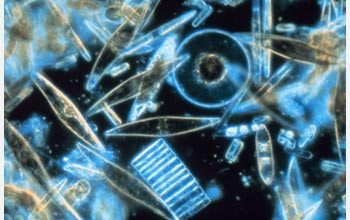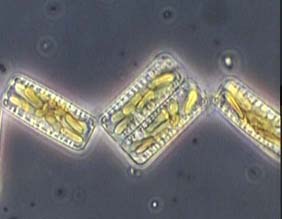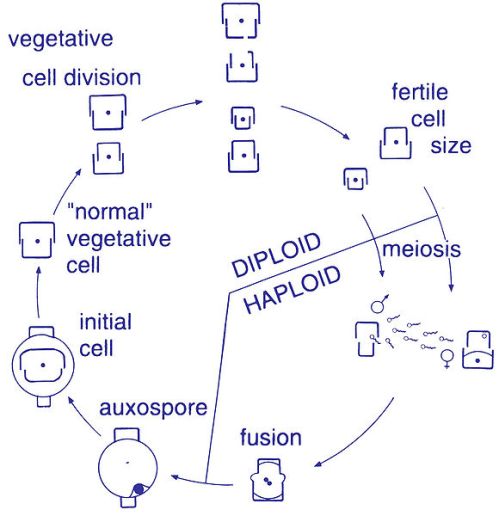
Reproduction
Diatoms like all of protists are able to
undergo sexual and asexual reproduction; also, like all protists
they predominately reproduction asexually. The mechanism they
use to reproduce asexually is simple mitosis. But they have a
slight problem. They are incased in a class shell. They way its
put together though is very useful for reproduction though (see
more in facts). The frustules fits
together like a Petr i dish, a larger valve called the epitheca
and the smaller valve called the hypotheca. When they divide
each cell ends up taking one of the valves for its epitheca.
They then proceed to secreting the hypotheca.
i dish, a larger valve called the epitheca
and the smaller valve called the hypotheca. When they divide
each cell ends up taking one of the valves for its epitheca.
They then proceed to secreting the hypotheca.
There are several problems their form of asexual
reproduction. Such as one of the cells is going to be
continuously be getting smaller and smaller. That isn’t
constructive for the cells. They find the solution to that
though their method of sexual reproduction.
Like many protest for sexual reproduction there has to be
particular triggers that cause diatoms to take the sexual
reproduction path way such as unfavorable conditions,
predations, time of year, ect. In the case of diatoms there are
several possible triggers. They could be the cell has gotten too
small, one of the valves was damaged (often the larger older
one), the conditions are unfavorable and they have to form a
vegetation cyst, and sometimes it’s just random.

Well to process by which diatoms go through sexual
reproduction is rather complex. First of all one of the cells
forms the male gametes, this if often a smaller cell, first the
cell divides into several smaller diploid cells that are called
spermatogonia and they remain within the frustule until it opens
and then they undergo meiosis to form haploid sperm. Then for
the female gametes there is three pathways in which it can go
depending on species. The first is they form oogonia (protective
mucus around diatom eggs ) containing two eggs. This way it
starts out undergoing and equal cytokinesis in the first
division of meiosis and the during the second meiosis there is
no cytokinesis. The second is an oogonia containing a single egg
and a polar body. This way starts by undergoing and unequal cell
division after the first cell division and then the second
division it does the same as the first form. Then the third form
is an oogonia containing a single egg. It is formed by
reductions divisions where there is no cytokinesis present and
ends up forming one large active nucleus formed by two smaller
pycnotic nuclei around it. These are also evolutionary steps and
the third form is the most derived form of how the eggs are
developed and the first form is the most primitive form of egg
development.
Then fertilization takes place by the sperm cell approaching
the egg and interning the oogonial thecae (outer coat of
the oogonia) through a sperm channel. It then goes and gets to
the egg cell and binds to it and from a zygote.
The zygote of a diploid cell is called an auxospore and it is
virtually a diatom without the silica shell. During this time
the cell grows rapidly but doesn’t divide. It undergoes and
incomplete mitosis lacking cytokinesis forming the epitheca on
the inside of the auxospore. Then one of the nuclei is removed
or broken down by the cell. The cell repeats the process again
to produce the hypotheca. This process ending with a complete
internalized diatom cell with everything including frustule.
Then the auxospore lyses open releasing the newly formed full
size diatoms cell.
There are variations of this between the
different phyla, classes, and orders.
To Interations